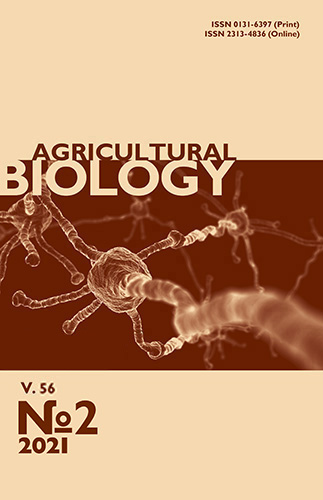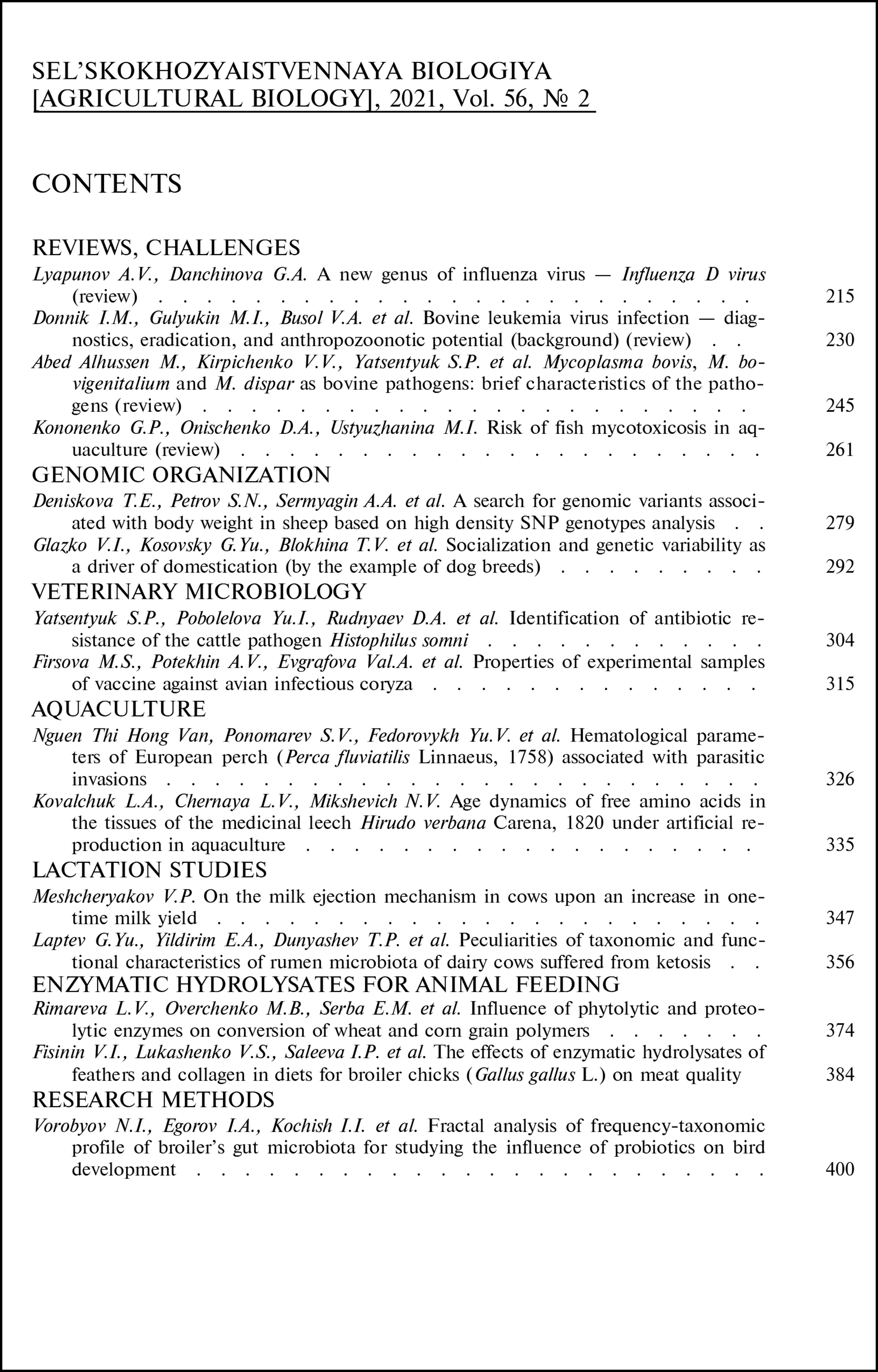doi: 10.15389/agrobiology.2021.2.335eng
UDC: 639.54:577.112.3
Acknowledgements:
The authors are sincerely grateful to Dr. G.I. Nikonov for the biomaterial provided and the invaluable support in conducting these investigations.
This research has been carried out within the state assignment to the Institute of Plant and Animal Ecology (Ural Branch of the Russian Academy of Sciences, Yekaterinburg) and supported in part by the Presidium RAS, grant 12-P-4-1049 (“Fundamental Sciences for Medicine”).
AGE DYNAMICS OF FREE AMINO ACIDS IN THE TISSUES OF THE MEDICINAL LEECH Hirudo verbana Carena, 1820 UNDER ARTIFICIAL REPRODUCTION IN AQUACULTURE
L.A. Kovalchuk1 ✉, L.V. Chernaya1, N.V. Mikshevich2
1Institute of Plant and Animal Ecology, Ural Branch RAS, 202, ul. 8 Marta, Ekaterinburg, 620144 Russia,e-mail kovalchuk@ipae.uran.ru (✉ corresponding author), Chernaya_LV@mail.ru;
2Ural State Pedagogical University, 26, pr. Kosmonavtov, Yekaterinburg, 620017 Russia, e-mail mikshevich@gmail.com
ORCID:
Kovalchuk L.A. orcid.org/0000-0003-0467-1461
Mikshevich N.V. orcid.org/0000-0003-2388-4278
Chernaya L.V. orcid.org/0000-0002-3386-9824
Received November 30, 2020
Medicinal leeches (Hirudo verbana Carena, 1820) used in veterinary medicine, human medicine and pharmacology, are currently bred artificially at bio-factories. The technology of leech culture as a component of aquaculture biotechnics is based on the method of accelerated growth of leeches due to intensive feeding, which allows you to get high-quality products in a fairly short time (8-10 months). Nevertheless, the problem of assessing the physiological status of raised individuals upon artificial reproduction remains not fully addressed. The findings we present herein for the first time allow us to suggest that the age-specific amino acid composition of tissues can be used to assess the physiological state and well-being of medicinal leeches in nature and in aquaculture. The aim of the work is to study the age-dependent content of the free amino acids in the tissues of medicinal leeches artificially bred in aquaculture. Studies were conducted in 2012 on the leech (Hirudo verbana Carena, 1820) individuals without signs of diseases which were purchased at the biofactory International Center for Medicinal Leeches (Moscow Province, p. Udelnaya). Leeches were kept in the laboratory in glass vessels with dechlorinated water at 20-22 oC and fed once a month with fresh bovine blood from healthy animals. The experimental specimens of H. verbana was: 5 days (newborn filaments, 0+), 1, 3, 5, 7 and 9 months old, with an average body weight of 0.029, 0.09, 0.25, 0.61, 1.33 and 1.81 g, respectively. Newborn individuals served as a control. The concentration of free amino acids (AA) in the skin and muscle tissue was determined on the analyzer AAA-339M (Mikrotechna, Czech Republic). A total of 105 leech specimens were used, 30 bioassays were prepared, and 660 element determinations were performed. The amino acid composition of the tissues of medicinal leeches H. verbana was represented by 23 AA and their derivatives. The dominant AA with an antioxidant orientation, regardless of age, were glutamine and glutamic acid, alanine, valine, leucine, and glycine, the total content of which was 65 % in filaments, and 58 % in 9-month — old individuals of the total fund AA. In the tissues of medicinal leeches, as well as in warm-blooded animals, the full composition of essential amino acids (EAA) was revealed: threonine, valine, lysine, leucine, isoleucine, histidine, arginine, methionine, phenylalanine, tryptophan. With age, the total concentrations of free amino acids decreased (r = -0.98 at p = 0.000), due to a sharp decrease in the content of arginine (24.0-fold), proline (13.4- fold), isoleucine (12.2- fold), glycine (8.5- fold), lysine (6.8- fold), histidine (6.6-fold), leucine (5.2-fold), ornithine (4.0- fold), glutamic acid and glutamine (3.8-fold), and alanine (2.9-fold). At the age of 5, 7 and 9 months, leeches had a trace content of secondary metabolites: taurine, citrulline and tryptophan (p < 0.001). However, the amino acid balance of nitrogen and protein metabolism was not disturbed, since the ratio of essential / non-essential AА did not change significantly and was 0.60 in newborn filaments, 0.73 — in 9-month-old leeches. It was found that the growth and development of H. verbana was accompanied by a significant decrease in the indicator of maturity (glycine/alanine) from 0.75 (newborn filaments) to 0.25 (9 months). The information available in the literature and the data of our research allow us to put forward the concept of using functional amino acids as biomarkers in the development of the scientific bases of technologies for the industrial breeding of these amphibionts.
Keywords: medicinal leeches, leech culture, free amino acids, age, physiological status.
REFERENCES
- Biological indicators of aquatic ecosystem stress. S.M. Adams (ed.). American Fisheries Society, Bethesda, Maryland, 2002.
- Hochachka P.W., Somero G.N. Biochemical adaptation: mechanism and process in physiological evolution. Oxford University Press, New York, 2002.
- Wu G. Amino acids: metabolism, functions, and nutrition. Amino Acids, 2009, 37(1): 1-17 CrossRef
- Storey K.B., Storey J.M. Biochemical adaptation to extreme environments. In: Integrative physiology in the proteomics and post-genomics age. W.Walz (ed.). Humana Press, 2005: 169-200 CrossRef
- Kovalchuk L.A., Mishchenko V.A., Mikshevich N.V., Chernaya L.V., Chibiryak M.V., Yastrebov A.P. Free amino acids profile in blood plasma of bats (Myotis dasycneme Boie, 1825) exposed to low positive and near-zero temperatures. Journal of Evolutionary Biochemistry and Physiology, 2018, 54(4): 281-291 CrossRef
- Ventura M. Linking biochemical and elemental composition of freshwater and marine crustacean zooplankton. Marine Ecology Progress Series, 2006, 327: 233-246 CrossRef
- Guisande C., Riveiro I., Maneiro I. Comparisons among the amino acid composition of females, eggs and food to determine the relative importance of food quantity and food quality to copepod reproduction. Marine Ecology Progress Series, 2000, 202: 135-142 CrossRef
- Brucet S., Boix D., López-Flores R., Badosa A., Quintana X.D. Ontogenetic changes of amino acid composition in planktonic crustacean species. Marine Biology, 2005, 148(1): 131-139 CrossRef
- Evdokimov V.V., Matrosova I.V. Tikhookeanskii meditsinskii zhurnal, 2014, 1(55): 48-51 (in Russ.).
- Golovina I.V., Gostyukhina O.L., Andreenko T.I. Rossiiskii zhurnal biologicheskikh invazii, 2016, 9(1): 53-66 (in Russ.).
- Chernaya L.V., Koval'chuk L.A. Vestnik Orenburgskogo gosudarstvennogo universiteta, 2008, 10(92): 225-229 (in Russ.).
- Chernaya L.V., Kovalchuk L.A., Nokhrina E.S. Role of the tissue free amino acids in adaptation of medicinal leeches Hirudo medicinalis L., 1758 to extreme climatic conditions. Doklady Biological Sciences, 2016, 466(1): 42-44 CrossRef
- Boëchat L.G., Adrian R. Evidence for biochemical limitation of population growth and reproduction of the rotifer Keratella quadrata fed with freshwater protest. Journal of Plankton Research, 2006, 28(11): 1027-1038 CrossRef
- Peres H., Oliva-Teles A. Effects of the dietary essential to non-essential amino acid ratio on growth, feed utilization and nitrogen metabolism of European sea bass (Dicentrarchus labrax). Aquaculture, 2007, 267(1-4): 119-128 CrossRef
- Portella M.C., Tacata R., Leitão N.J., Menossi O., Kwasek K., Dabrowski K. Free amino acids in Pacu, Piaractus mesopotamicus, eggs and larvae. Journal of the World Aquaculture Society, 2013, 44(3): 425-434 CrossRef
- Song Z., Wang J., Qiao H., Li P., Zhang L., Xia B. Ontogenetic changes in digestive enzyme activities and the amino acid profile of starry flounder Platichthys stellatus. Chinese Journal of Oceanology and Limnology, 2016, 34(5): 1013-1024 CrossRef
- Osako K., Kurokawa T., Kuwahara K., Nozaki Y. Seasonal variations in taurine and histidine levels of horse mackerel caught in the East China Sea. Fisheries Science, 2004, 70(6): 1180-1182 CrossRef
- Parvathi K., Karthegaa J. Influences of isolated probiotics on amino acid profile of fresh water fish Cyprinus carpio. International Journal of Recent Scientific Research, 2017, 8(11): 12417-12419 CrossRef
- Karanova M.V. Rossiiskii fiziologicheskii zhurnal im. I.M. Sechenova, 2017, 103(1): 89-97 (in Russ.).
- Baskova I.P., Kharitonova O.V., Zavalova L.L. Biomeditsinskaya khimiya, 2011, 57(5): 511-518 CrossRef (in Russ.).
- Abdisa T. Therapeutic importance of leech and impact of leech in domestic animals. MOJ Drug. Des. Develop. Ther., 2018, 2(6): 235-242 CrossRef
- Kustov S.Yu., Gorbunova Yu.K., Vardo L.E. Trudy Kubanskogo gosudarstvennogo agrarnogo universiteta, 2014, 48: 69-72 (in Russ.).
- Ceylan M., Küçükkara R., Akçimen U., Çetinkaya O. Reproduction efficiency of the medicinal leech Hirudo verbana Carena, 1820. Turkish Journal of Fisheries and Aquatic Sciences, 2015, 15(1): 417-424 CrossRef
- European convention on protection of the vertebrate animals used for experiment or in other scientific purposes (Strasbourg, on March, 18th, 1986). Available: https://www.coe.int/en/web/conventions/full-list/-/conventions/rms/090000168007a67b. No date.
- Yarri D. The ethics of animal experimentation. Oxford University Press, New York, 2005.
- Chessel D., Dufour A.B., Thioulouse J. The ade4 package-I: One-table methods. R News, 2004, 4: 5-10.
- Love R.M. The chemical biology of fishes. London, New York, 1980.












